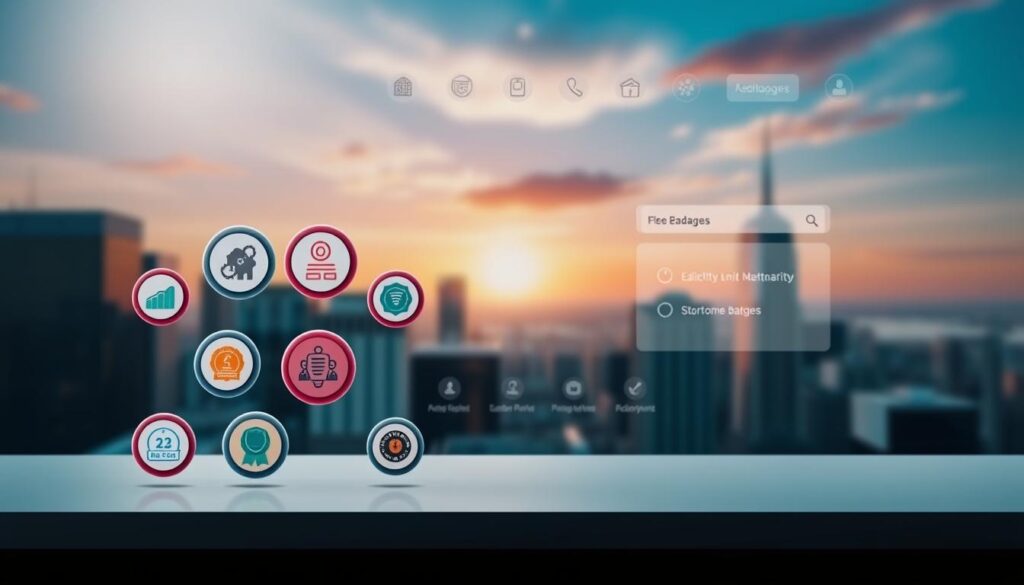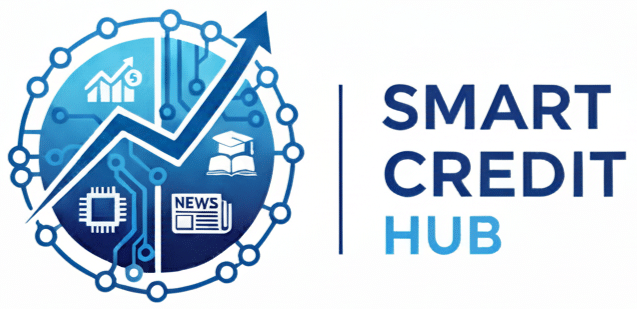About 70% of employers think online badges show job-ready skills. Yet, many people still wonder what digital badges are. They also question how these badges differ from traditional certifications.
Digital badges show skills, achievements, or professional certifications in a digital form. Unlike paper certificates, they have detailed info like who issued them, what you did to get them, and when. This makes it easy for anyone to check if they’re real online.
Related content:
You will stay on the same website.
This new way of showing what you know has become popular in colleges, workplaces, and for professional growth across the U.S. There’s a set of rules called the Open Badges framework. It was started by Mozilla and is now run by IMS Global. This makes sure digital badges can be used in many places.
This article aims to explain digital badges. We’ll look at how they work online, compare them with traditional certifications, and discuss what they mean for learners, employers, and educators thinking about using them.
Understanding Digital Badges
Digital badges show how we understand learning and skills today. They explain what these credentials mean. They also show what makes them different. And how they are used in places like schools and companies.
Definition of Digital Badges
Digital badges are like online medals for what you achieve. Inside each badge is info that tells what the badge is for, who gave it, and why. This information helps make everything clear for jobs and schools.
Key Characteristics of Digital Badges
You can show your badges on LinkedIn, websites, and resumes. This displays your skills. Badges have metadata that anyone can check. This shows who gave out the badge and what for. They focus on specific skills, not just big degrees. There are common rules for badges. This means they work the same way on many websites.
Examples of Digital Badges in Use
Places like Coursera and edX give out badges for completing parts of courses. Credly and Badgr make sure these badges are real. They also manage them. Groups like the Project Management Institute give badges with their traditional certificates. This shows you’re keeping your skills fresh.
In schools, colleges, job training, and company learning programs, badges mark specific skills. They use virtual badges as rewards. Open badges let schools and programs share proof that you really earned them.
| Use Case | Example Issuer | Badge Type | Primary Benefit |
|---|---|---|---|
| Online course module | Coursera | Micro-credential badge | Signals completion of a focused skill |
| Professional certification add-on | Project Management Institute | Digital credential | Updates credential portability and verification |
| Issuer platform | Credly | Verifiable badge | Centralized management and metadata display |
| Education initiative | Badgr | Open Badges | Interoperable sharing across LMS and portfolios |
The Importance of Digital Badges
Digital badges are changing how we recognize skills. They set clear goals for learners and help employers find right talents quickly. Companies like IBM and Microsoft prove that digital credentials are valued in hiring.
Benefits for Learners
Micro-credentials make big goals easier to reach. They motivate learners by rewarding specific achievements. This makes sharing skills on LinkedIn and résumés easy.
Badges encourage ongoing learning. They let people show their skills without waiting to finish a degree. This is especially helpful for those learning while working.
Advantages for Employers
Employers use badges for skills-focused hiring. They can easily see who has the needed skills. This makes hiring faster and better suited to what companies need.
Digital badges also help with training and planning for future needs. They allow managers to see who learned new skills and where more training is needed.
Enhancing Career Opportunities
Career progress is clearer when combining micro-credentials. IT, healthcare, and project management pros keep up with tech changes. They get new badges to show their growing skills.
Career changers use badges to show their skills in new fields. Employers that accept digital badges welcome diverse talents. This leads to quicker changes in the workforce.
| Stakeholder | Primary Benefit | Real-World Example |
|---|---|---|
| Learners | Motivation from micro-goals and shareable verified achievements | Stackable badges used by Coursera learners to highlight course skills on LinkedIn |
| Employers | Faster skills-based hiring and measurable competency tracking | Microsoft’s certification pathways used in technical recruitment |
| Career Changers | Pathways that combine badges into broader credentials | IT bootcamp graduates assembling micro-credentials into recognized professional profiles |
| Industry Trend | Growing acceptance of digital credentials in hiring decisions | Surveys show more HR teams consider badges alongside degrees when shortlisting |
Types of Digital Badges
Digital badges come in various forms. They benefit learners, professionals, and people in communities. They fit into modern badge systems and pathways for earning micro-credentials.
Educational Badges
Educational badges are offered by schools, colleges, MOOCs, and programs for continuing education. Places like Purdue University and the University of Illinois give out e-badges. These show when a course is finished, a skill is mastered, or certain goals are met.
These badges capture skills not shown on regular transcripts. Students can gather proof of their skills across different courses. This makes it easy to build up their micro-credentials.
Professional Badges
Industry groups and professional organizations issue professional badges. Examples are given by CompTIA, Microsoft Learn, and the Project Management Institute. These badges prove a person has certain skills, has continued their education, or reached recertification goals.
Companies use badges to match skills with job needs. This lets workers show their skills on resumes and professional profiles. It’s helpful proof of what they can do.
Community and Participation Badges
Community badges are given for volunteer work, being in hackathons, contributing to open-source projects, and taking part in civic activities. The Wikimedia Foundation and sites for volunteers reward contributions with badges. This shows the value of someone’s effort and impact.
These badges can be collected to show continuous service. They help strengthen community ties and motivate ongoing engagement.
How Digital Badges Work
Digital badges allow an easy way to verify achievements online. Each badge shows who earned it, the criteria met, and where to find more evidence. This setup makes it simpler for employers and educators to see someone’s skills without much hassle. The following sections delve into the technology, how to verify these badges, and the role of those who issue them.
The Technology Behind Digital Badges
Open Badges include special data called JSON-LD in each badge file. This data mentions the issuer, criteria for receiving the badge, a link to evidence, and standards followed.
Badges are kept on platforms like Credly, Badgr, and Accredible. These platforms let badges be shared on social media or placed in a digital backpack. They can connect to learning systems to issue badges right when a course is finished.
Verification and Credibility
To verify a badge, you check its special data. This process makes sure the issuer is real, confirms the badge wasn’t issued before it should be, and looks at public proof. Some systems also use special signing to prevent false badges.
This method makes it easier for managers to trust a badge. They don’t need to reach out to the issuer directly. The public proof and who issued the badge play a big part in its value during hiring.
The Role of Badge Issuers
Universities, employers, and groups can issue badges. They decide what earning the badge involves, how to assess it, and what proof is needed. They also handle tasks like removing or updating a badge.
It’s critical for issuers to be clear and strict in their assessments. Trustworthy issuers help make digital badges more accepted. Using standards that work together helps badges be used in many places, like online profiles or with employers.
| Aspect | What It Contains | Why It Matters |
|---|---|---|
| Metadata (JSON-LD) | Issuer name, criteria, evidence URL, alignment | Enables automated verification and clear context for the badge |
| Hosting Platforms | Credly, Badgr, Accredible, LMS integration | Store badges, expose APIs, automate issuance and sharing |
| Verification Methods | Metadata checks, issuer authentication, cryptographic signing | Protects against fraud and confirms authenticity |
| Issuer Responsibilities | Define criteria, assess learners, publish evidence, manage revocation | Ensures credibility and long-term value of virtual badges |
| Interoperability | Badge backpacks, social sharing, LMS automation | Makes open badges portable and supports wider adoption |
Digital Badges vs. Traditional Certifications
Digital badges and micro-credentials are becoming popular. They show skills in a new way. People compare them to traditional certifications to see what’s best for their careers or hiring needs.
Comparison of Validity
What’s valid depends on who gives the badge and how. Badges from places like IBM or Coursera show specific skills. Traditional certifications, like those from CompTIA, test a wider range of skills with proctored exams.
Employers look at the evidence behind both types. A badge might show a specific skill. A certification suggests a broader education and oversight. The issuer’s reputation and clear assessments make both more credible.
Cost and Accessibility
Digital badges are cheaper and flexible. Online platforms offer them, so you can learn at your own pace. This makes learning more accessible for everyone, including those working full time or living in remote areas.
Traditional certifications can be pricey and hard to get. They might involve fees for exams, courses, and renewals. Starting with badges can be a more affordable way to gradually build towards bigger certifications.
Public Perception of Badges
Opinions on digital badges are evolving. More schools and employers now accept them, especially if they meet certain standards. When well-known organizations issue the badges, they’re taken more seriously.
However, some jobs still value traditional certifications more. Badges that lead to these certifications can change minds and help in career growth.
| Criterion | Digital Badges | Professional Certifications |
|---|---|---|
| Assessment Type | Targeted assessments, project-based, often online | Comprehensive exams, sometimes proctored, standardized |
| Cost | Lower per unit, modular pricing, subscription options | Higher upfront fees, prep costs, recurring renewal fees |
| Accessibility | High; remote access, flexible timing, shorter duration | Variable; in-person or scheduled online exams, time-intensive |
| Perceived Authority | Growing; depends on issuer reputation and transparency | Established; long history and broad recognition |
| Use Case | Skill demonstration, continuing education, portfolio building | Job entry requirements, licensing, advanced career steps |
| Pathway Potential | Can stack into larger credentials or prepare for certification | May accept prior learning or badge-based prerequisites |
The Process of Earning a Digital Badge
Getting a digital badge starts with a clear plan and known rules. You learn about digital badges by following steps, showing proof, and taking tests to show you’ve mastered a skill.
Steps to Obtain a Badge
1. Sign up for a course or program from places like Coursera or a university.
2. Do all the required learning activities such as lessons or labs that are needed.
3. Show what you’ve learned by submitting projects or taking quizzes.
4. The issuer checks your work or test scores.
5. If everything checks out, you get your badge to share on LinkedIn or other platforms.
Requirements for Badge Issuance
Issuers need to see you’ve really learned something. This might mean finishing courses, passing tests, or showing a portfolio that meets their standards.
Some badges also need projects watched by someone or tests taken with supervision. The badge details should tell you about these requirements.
Having clear rules and showing your work makes digital badges valuable. It helps employers quickly see what skills you have.
Assessment Methods Used
How they check your skills can vary. For basic knowledge, they might use multiple-choice tests.
For more hands-on skills, they use project tasks or simulations. Reviews by peers or teachers also play a part.
Some tests are automated or timed for bigger programs. High-stakes credentials often require proctored exams.
Being clear about how skills are tested and showing proof helps badge holders show their skills confidently with online badges and e-badges.
Platforms for Creating Digital Badges
Organizations pick platforms to create and handle digital badges. They look for what fits learners and employers best. The choice of platform hinges on needs for scale, privacy, API access, and recognition goals.

Popular Badge-Making Platforms
Credly focuses on enterprises and professional groups, emphasizing employer recognition. Badgr is aimed at educators and teams, valuing open standards and classroom integration. Accredible is perfect for schools and bodies needing sleek certificates and detailed analytics. Canvas Badges offers tools for instructors inside the Canvas LMS. Microsoft backs vendor credentials and industry tests.
Features of Top Tools
These platforms allow custom badge design and adhere to Open Badges standards. They automate badge giving based on achievements. They attach proof to each badge, let issuers pull badges back if necessary, and provide program analytics. Badges can be shared on social media, showing off the holder’s success.
Integration with Learning Management Systems
Badge platforms can connect with LMS to automatically issue badges. They work with systems like Canvas, Moodle, and Blackboard. This setup tracks learner progress and aids in managing large groups easily.
Choosing involves thinking about growth, privacy, and cost. API possibilities are key for tailored experiences. Matching a provider with an institution’s aims makes sure the badge program aids in hiring, skill development, or academic recognition.
The Role of Digital Badges in Education
Digital badges are changing how learning milestones are viewed in education. They allow for the recognition of specific skills, leading up to bigger achievements. This approach to micro-credentials is becoming more popular, offering a clear link between education and job demands.
Enhancing Curriculum Design
Digital badges support teaching by breaking courses into smaller, testable units. Teachers make detailed guides for each badge. This shows students exactly what skills they need.
This method also fits personalized learning. Students move forward by showing what they know, not just by time spent. Places like Southern New Hampshire University use these badges in ways that let students earn college credits or certificates.
Supporting Lifelong Learning
Digital badges make learning achievements portable. This is great for adults changing jobs or schools. It lets them build and show their skill growth over time.
Many employers, especially in technology and healthcare, value these credentials for training. Badges also make it simple to combine learning from different places into one record.
Measuring Student Achievement
Badges give detailed proof of what a student has learned. They can include work samples and tests as evidence. This adds to the usual grades.
They also provide teachers with valuable feedback on how skills are learned. This helps align teaching with job market needs. Digital platforms make sharing success with businesses and schools easier.
Utilizing Digital Badges in the Workplace
Digital badges let companies show off learning achievements. They keep track of training steps, confirm skills, and celebrate career growth. This helps bosses see team progress and inspires workers to keep getting better.
Employee Training and Development
Big names like Deloitte and IBM use badges in their training. They reward employees for learning new things and mastering skills. This encourages workers to aim for promotions, linking learning directly to career success.
Skills Tracking and Recognition
HR teams use badges to clearly see who knows what. Tools by Credly and Cornerstone help spot who’s best for a project. Giving badges publicly also keeps morale high and staff around longer.
Building a Badge System within Organizations
Starting a badge program means setting skills and badge requirements first. Pick a tech platform that checks and shares badge info easily. Try it in one area, get thoughts, and tweak as needed before going big.
Getting staff on board is key. Spread the word through company updates, manager talks, and fun rewards. Check the program’s success by looking at course completions, job fits, and how staff move up or around.
Places like the U.S. Department of Labor and Microsoft also use badges. They prove digital badges and skill tracking can really help with teaching staff and planning for the company’s future.
The Future of Digital Badges
Learning and hiring online are changing. Digital badges will soon show and confirm our skills in new ways. With more people learning from home, and companies looking for specific skills, digital badges are becoming key. Edtech companies and standards set by groups like IMS Global are helping. They make digital badges easier to use and trust.
Trends Impacting Badge Adoption
Platforms like Coursera and edX are making small credentials popular. Companies, from Microsoft to Accenture, now want people with clear skills, not just degrees. Standards from IMS Global help share these credentials smoothly.
Money keeps flowing to new companies that deal with badges. This money helps schools and businesses get on board with digital badges faster.
Predictions for Growth and Usage
Colleges, companies, and professional groups will use badges more. These small credentials will show clear paths to jobs that employers and schools like.
Job sites will use badges to find the right people. Badges will connect directly to job openings and learning opportunities.
Challenges Ahead for Digital Badges
Creating common rules for badges is tough. Different fields have different needs, which can confuse both learners and companies. Making sure badges are trustworthy will be very important.
We must handle private information carefully. Also, we need to make sure everyone has equal access to these badges. Using blockchain, better metadata, and analytics could help solve these issues. But, these solutions need both money and oversight to work.
| Area | Current State | Near-Term Outlook |
|---|---|---|
| Remote Learning | Widespread use of platforms offering micro-credentials | Expanded integration with university and corporate programs |
| Employer Adoption | Growing interest in skills-based hiring | Routine use of virtual badges in recruiting and promotion |
| Standards & Interoperability | Emerging frameworks from IMS Global and others | Greater portability and verification across systems |
| Technology | Initial pilots with blockchain and analytics | Robust credentialing ecosystems with rich metadata |
| Equity & Access | Uneven access to high-quality badge programs | Targeted efforts to widen participation and affordability |
Best Practices for Implementing Digital Badges
A clear plan is key for organizations to make credentials trusted signals. We’ll go over steps for badge design, e-badge promotion, and best practices. These tips will help increase adoption and have a real impact.
Designing Effective Badges
Start with clear, measurable learning outcomes. Each badge should represent specific skills and have clear assessment criteria.
Demand evidence like project work or supervisor sign-off. Include Open Badges metadata for easy sharing across platforms like Credly and Badgr.
Use well-known issuer branding, such as Coursera or LinkedIn Learning, to build trust. Keep badge designs consistent to help employers recognize their value easily.
Strategies for Promotion
Develop a communication plan aimed at learners, hiring managers, and HR teams. Use emails, onboarding materials, and intranet posts to showcase badge value.
Feature badge links on LinkedIn, company sites, and job postings. Create a page that clarifies how badges are assessed and what they mean.
Watch how people share and interact with badges to improve your promotion. Share stories of real-world success to catch employers’ eyes.
Engaging Stakeholders in Badge Programs
Get input from faculty, HR, and industry partners to make criteria relevant. This teamwork boosts acceptance across sectors.
Create boards with employers to ensure badges meet market needs. Involve learners in giving feedback to keep the focus on them.
Set clear rules on badge issuance, appeals, and revocation. Having transparent policies builds trust and encourages ongoing participation.
Measuring Success: KPIs to Monitor
Watch how many badges are issued and the time it takes to earn them. Track LinkedIn shares and views to see how visible they are.
Survey employers and check hiring data to understand badge recognition. Note promotions and internal moves to gauge career impacts.
Evaluate satisfaction through surveys and scores. Use feedback to improve badge design and program practices.
Governance and Continuous Improvement
Review assessment processes regularly. Update criteria with industry changes and keep records public for clarity.
Test with pilot programs before full launch. Use findings to tweak technology, processes, and promotion strategies.
Keep a record of what you learn and share with partners. A focus on continuous improvement ensures badges meet both employer and learner needs.
Case Studies on Successful Badge Programs
Here, we look at real examples showing badges’ impact on learning and job markets. These examples cover universities, big companies, and community organizations. They link design choices to benefits like better job fitting, more involvement, and clearer paths to career growth.
Examples from Educational Institutions
Purdue University gives out curriculum badges. These help students show they have specific skills from their courses. The badges meet what employers are looking for and let students highlight abilities beyond just a diploma.
University of Maryland Global Campus has a program for educational micro-credentials. It’s aimed at what employers need. These small, focused courses lead to clear career paths that employers recognize.
Some community colleges offer stackable certificates. For instance, a college focusing on manufacturing has badges that help students progress towards being technicians. They earn credentials along the way that employers really value.
Corporate Badge Initiatives
Microsoft gives out badges through Microsoft Learn for tech topics. These badges show someone has mastered certain technology skills. They help with moving up in the company or finding a job elsewhere.
IBM has a big digital badge program. It covers skills that are really in demand, like data science and cybersecurity. These badges help during hiring and when setting up training programs.
Companies often link badges to career progress. Badges can be tied to getting a promotion or a raise. This makes people more engaged and makes their skills more visible to others at work.
Nonprofit and Community-Based Programs
The Wikimedia Foundation gives out badges for things like volunteer training and leadership. These badges show someone’s contributions and encourage them to keep participating.
Local groups have badge programs for digital skills and responding to emergencies. These help volunteers get skills that are recognized and that can help them get paid jobs or positions in the community.
Nonprofit and community programs help make the workforce stronger. They offer cheaper ways to get recognized skills. People get results that employers trust.
| Sector | Issuer | Focus | Reported Outcomes |
|---|---|---|---|
| Higher Education | Purdue University | Curriculum-linked competency badges | Improved employer signaling; higher student portfolio quality |
| Higher Education | University of Maryland Global Campus | Modular educational micro-credentials | Faster upskilling; clearer career pathways for adult learners |
| Community College | Regional community colleges | Stackable certificates aligned with local jobs | Better employer alignment; increased local hiring |
| Corporate | Microsoft | Technical skill badges via Microsoft Learn | Enhanced talent mobility; streamlined recruiting |
| Corporate | IBM | Industry skill badges | Clear skill mapping to roles; higher credential recognition |
| Nonprofit | Wikimedia Foundation | Volunteer and editorial badges | Greater volunteer retention; validated community contributions |
| Community | Local civic groups | Digital literacy and emergency response badges | Measurable workforce readiness; paths to paid roles |
Legal and Ethical Considerations
Legal and ethical issues shape how we handle digital credentials. Clear rules help avoid debates about rights and privacy. Everyone involved should stick to standards to keep trust and follow laws.
Issues of Ownership and Privacy
Who owns digital badges is a big question. It’s about if the person who gets the badge or the one who gives it controls the data. People who earn badges want to choose who sees them. But those who issue badges need to keep evidence safe while respecting rights.
Laws like FERPA set rules for how schools handle records. Privacy laws differ by state and affect many areas. Keeping data safe, using encryption, and making consent clear protect badge privacy.
Ensuring Equity in Badge Distribution
Equity starts with clear and fair criteria. Open guidelines and outlined goals make assessments fair. Tests need to be reachable for everyone, including those with disabilities, and available in different languages if needed.
Charging fees might leave some people out. Making options affordable or free and teaming up with colleges or groups helps everyone. Watching who gets badges helps find and fix fairness issues.
Addressing Misuse of Badges
Fraud and misuse can harm badge trust. Fighting this needs strong checks linking badges to real achievements. Rules for taking back badges must be clear and followed when someone breaks them.
It’s key that issuers are responsible. Platforms like Credly and Badgr keep to global standards to ensure badges are real. Linking evidence publicly and keeping logs help stop misuse.
Using strong guidelines and sticking to global standards ensures legal and ethical credentialing. These actions build lasting trust in the badge world.
Conclusion: The Role of Digital Badges in Professional Development
Digital badges and micro-credentials are vital in today’s job market. They help show off specific skills that resumes and LinkedIn profiles might not cover. As Credly and Coursera make more credentials available online, people have better chances to keep learning and move up in their careers.
More companies will start using digital badges as they become easier to share and understand. Big names like IBM and Google already prefer to hire based on skills rather than just degrees. This shift means digital badges could soon stand alongside, or even replace, traditional certificates.
It’s important for learners to choose well-respected badge programs that offer valuable skills. Employers should try out these badge systems in their hiring and training. This way, they can spot talented people more easily. Both learners and employers need to pick digital badges carefully to prepare for the future of work.



